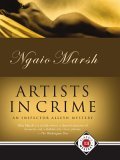by Linda Triegel
Most writers grow fond of the characters they create, but there must be a special relationship between writers and series characters that, with skill on the writer’s part and staying power on the character’s, appear to change and mature through the life of the series. Between female mystery writers and their detectives, there is an even more finely tuned rapport. These ladies must be at least a little in love with their creations.
Was Roderick Alleyn Dame Ngaio Marsh’s ideal man? In fiction, reader identification is crucial; the reader, if male, must want to be the hero, the female reader must want to meet him. In order to create so admirable and desirable a character on the printed page, the writer must see him clearly in her mind before ever she sets fingers to keyboard.
 Alleyn first appeared in 1934 in A Man Lay Dead and last in 1982 in Light Thickens, having aged gracefully in the interval by no more than a dozen years.
Alleyn first appeared in 1934 in A Man Lay Dead and last in 1982 in Light Thickens, having aged gracefully in the interval by no more than a dozen years.
Doubtless his marriage to painter Agatha Troy—they met in Artists in Crime and became engaged in Death in a White Tie—accounts for his ageless grace.
 |
Alleyn is Eton and Oxford-educated; his father was in the diplomatic service, but Rory unaccountably chose to be a policeman.
“his eyes grey with corners that turn down; they look as if they would smile easily, but his mouth doesn’t” (A Man Lay Dead),
“terribly good-looking and remote” (Death in a White Tie),
“monkish-looking with a fastidious mouth and well-shaped head” (A Wreath for Rivera), and frequently as looking like a grandee.
 Troy finds him a perfect subject, and painted him from memory after their first meeting.
Troy finds him a perfect subject, and painted him from memory after their first meeting.
Personally, I find Alleyn a little too good to be true, or comfortable to be around. Josephine Tey’s Alan Grant, on the other hand, perhaps because he is less graphically defined, seems easier to live with. Grant too doesn’t like the conventional idea of a policeman (none of these heroes do; one wonders what the genuine article does look like.)
“six-foot-odd” (in The Daughter of Time),
“slight of build” and “chic” of dress (The Man in the Queue).
He is well-off financially, having inherited money from an aunt in Australia to supplement his salary from the Yard.
 He is human enough to have a hobby (fishing, which he describes to his doctor as “somewhere between a sport and a religion”), to be a little on the clumsy side (falling through a trapdoor while chasing a crook land him in the hospital where the discovers the perils of historical research in The Daughter of Time), and to suffer from overwork like any other civil servant (the fishing was prescribed for an attack of nerves leading to Scotland and The Singing Sands).
He is human enough to have a hobby (fishing, which he describes to his doctor as “somewhere between a sport and a religion”), to be a little on the clumsy side (falling through a trapdoor while chasing a crook land him in the hospital where the discovers the perils of historical research in The Daughter of Time), and to suffer from overwork like any other civil servant (the fishing was prescribed for an attack of nerves leading to Scotland and The Singing Sands).
P.D. James’s ideal man is Adam Dalgliesh, who is also 6’2” and dark (I’d hazard a guess that all these writers are petite blondes). He has a “detached, ironic, and fundamentally restless spirit,” which is reflected in the poems he writes to get his mind off his cases. Dalgliesh is a widower, with no family but an elderly Aunt Jane in Sussex.
 James herself has described him (in an article in Murder Ink) as
James herself has described him (in an article in Murder Ink) as
“a very private person, self-sufficient, uninvolved, a professional detective dedicated to his job, totally unused to the claims, emotional and domestic, which a wife and family would make on him.”
He does have a lady friend to whom he is on the verge of proposing in Unnatural Causes, but she wises up and dumps him (if any lady may be said to do such a thing to Adam Dalgliesh).
There are other detectives in this mold—Margery Allingham carries on an on-again-off-again romance with one Albert Campion—but not all female writers by any means are devoted to them.
 Dorothy L. Sayers’s Lord Peter Wimsey is another kettle of red herring altogether—an amateur detective, not a professional, he is small, with straw-colored hair, a long face and pointed chin, grey (sometimes blue) eyes, attractive or not depending on whether you are Harriet Vane observing her sleeping lord in a punt on the Cherwell or a murderer having been caught by Peter’s formidable intelligence and skewered by his sharp wit (or depending, if you’ve seen the TV series, whether you prefer Ian Carmichael or Edward Petherbridge as Wimsey.) Readers, like other impressionable adolescents, are subject to crushes on the likes of Peter Wimsey, but they don’t last.
Dorothy L. Sayers’s Lord Peter Wimsey is another kettle of red herring altogether—an amateur detective, not a professional, he is small, with straw-colored hair, a long face and pointed chin, grey (sometimes blue) eyes, attractive or not depending on whether you are Harriet Vane observing her sleeping lord in a punt on the Cherwell or a murderer having been caught by Peter’s formidable intelligence and skewered by his sharp wit (or depending, if you’ve seen the TV series, whether you prefer Ian Carmichael or Edward Petherbridge as Wimsey.) Readers, like other impressionable adolescents, are subject to crushes on the likes of Peter Wimsey, but they don’t last.
Some writers, of course, prefer sleuths of their own gender, from Agatha Christie’s Miss Marple to Janet Evanovitch’s Stephanie Plum, but this takes us into almost another genre. For a romance writer turned mystery reader, I retain a lingering yen for a hero.



Comments
One response to “Grande Dames and Great Detectives”
Fantastic collection of books here. I've read almost all of them and recommend them.